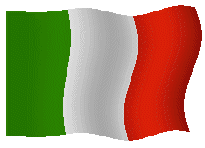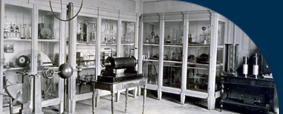
 |
De la Rive electric egg |
 |
Uovo elettrico di De la Rive |
| Subject: meteorology/aurora borealis theory |
Settore: meteorologia/teoria dell'aurora boreale |
| Number of catalogue: 47 |
Numero di inventario: 47 |
| Engraved on the mahogany base: "Secretan à Paris" |
Sulla base di mogano: "Secretan a Paris" [inciso] |
| 1865 [document] |
Periodo di costruzione: 1865 [documento] |
| £ 144 [document] |
Prezzo d'acquisto: £ 144 [documento] |
| Mahogany, brass, glass, iron, ebonite, copper |
Materiali utilizzati: Mogano, ottone, vetro, ferro, ebanite, rame |
| Base: ( 270 mm; height: 735 mm |
Dimensioni: Base: Ø 270 mm; altezza: 735 mm |
| |
|
From surviving documents it is evident that this instrument was purchased in Paris by the mechanician Secretan for a cost of £ 144 and it came to Urbino in 1865. Within the document the following inscription is found next to the price: "De la Rive electric egg, for the rotation of a luminous arc produced by a Rumkorff coil, purchased previously, around a magnet - displaying the analogy between the aurora borealis and electric discharge". The instrument is powered by a Ruhmkorff coil and connected to a pneumatic pump, and demonstrates the rotatory effect of a magnetic field on an electric discharge in a rarefied gas. This device was proposed by the Swiss physicist Arthur-Auguste De la Rive (1801-1873) in order to reproduce through experimentation the analogy between the aurora australis and the aurora borealis (at that time it was thought that they could take place only in the two polar hemispheres) and the electric discharge. His electric theory stated that the aurora, being influenced by the earth's magnetic field, would take place in the polar regions through processes of discharge between the positive electricity concentrated in the upper regions of the atmosphere and the negative electricity of the Earth. De la Rive's theoretical hypothesis was more credible due to the observation, in that period, of a kind of rotational movement of the aurora borealis.
|
Da alcuni documenti sappiamo che lo strumento fu acquistato a Parigi dal meccanico Secretan al prezzo di £ 144 ed arrivò in Urbino il 29 marzo 1865. Nel documento, accanto al prezzo, è riportata la seguente dicitura: «Ovo elettrico di De la Rive, per la rotazione intorno a una calamita dell'arco luminoso prodotto dal Rocchetto di Rumkorff, già acquistato in passato - esperienza che mostra le analogie tra le aurore boreali e le scariche elettriche». Esso, quindi, alimentato con un rocchetto di Ruhmkorff e collegato ad una pompa pneumatica, permetteva di mostrare l'effetto rotatorio di un campo magnetico su una scarica elettrica in un gas rarefatto. Questo apparato fu ideato dal fisico svizzero Auguste Arthur De la Rive (1801-1873) per riprodurre sperimentalmente l'analogia tra le aurore australi e boreali (che allora si riteva potessero manifestarsi solo nei due emisferi polari) e le scariche elettriche. La sua teoria elettrica delle aurore prevedeva infatti che esse, influenzate dal campo magnetico terrestre, avvenissero nelle regioni polari tramite processi di scarica tra l'elettricità positiva accumulata nelle alte regioni dell'atmosfera e la negativa del globo terrestre. La verifica infine, di una specie di moto rotatorio che era stato osservato nelle aurore boreali rendeva più credibile, secondo il fisico ginevrino, la sua presunta ipotesi teorica. |
| |
|
Description: The instrument rests upon a solid circular mahogany base and vertically supports a magnet and an egg-shaped glass ball. In the upper part, the ball is a pair of brass taps: the one that is placed higher produces a first vacuum with a pneumatic machine; the other is used to introduce some drops of ether or of turpentine oil into the ball and then, with the pneumatic machine, to achieve an extremely rarefied vapour. A soft iron rod is contained in the air-tight glass egg for 3/4 of its height and is connected to a polar expansion iron electromagnet at the base of the glass egg. Except for its extremities, the iron rod is entirely covered by a glass tube that is insulated by a layer of shellac. The part of the glass tube that is inside the egg is wrapped by a copper ring on the bottom and enclosed by an iron lid on top. A pair of brass rheofores, positioned halfway up the device, electrically connect the copper ring with the iron lid. A second pair of brass rheofores, on the mahogany base of the instrument, provides for the energy supply to the electro-magnet. |
Descrizione: Lo strumento, che poggia su una solida base circolare in mogano, sostiene verticalmente un elettromagnete e un pallone di vetro a forma di uovo. Il pallone è munito superiormente di una coppia di rubinetti d'ottone: l'uno, posto più in alto, produce un primo vuoto tramite una macchina pneumatica; l'altro viene utillizzato per introdurre nel pallone alcune gocce d'etere o d'essenza di trementina e quindi, di nuovo azionando la macchina pneumatica, per raggiungere un vapore estremamente rarefatto. Entro l'uovo di vetro è alloggiato per 3/4 della sua altezza un'asta di ferro dolce che, attraversando a tenuta l'uovo, va a ricongiungersi ad incastro con l'espansione polare in ferro di una elettrocalamita. L'asta è protetta per l'intera sua lunghezza, tranne che per le estremità, da un tubo di vetro ben isolato da uno strato di gommalacca. La parte di tubo dentro l'uovo è avvolto inferiormente da un anello in rame e chiuso superiormente da un coperchio in ferro. Una coppia di serrafili in ottone, posizionati a metà altezza, collegano elettricamente l'anello di rame e il coperchio in ferro. Una seconda coppia di serrafili in ottone, posizionati sulla base in mogano dello strumento, provvede all'alimentazione dell'elettrocalamita.
|
| |
|
Function: A beam of light is produced within the glass egg by supplying only the copper ring and the cylinder's iron lid protecting the rod. The beam is more or less regular and is spread all around the rod, as was the case in the experiment of the electric egg. By supplying the electro-magnet as well, the phenomenon changes, and the dispersed light concentrates in only one beam of light that starts rotating slowly around the poles of the magnetised cylinder, alternating the direction of its rotation according to the direction of the induced current, is manually reversible through a Ruhmkorff commutator on the base of the instrument. This instrument, is now kept in Urbino, still operates and is well-preserved. |
Funzionamento: alimentando l'anello inferiore di rame e il coperchio superiore di ferro dell'asta, si produce all'interno del pallone un fascio luminoso, più o meno regolare, diffuso tutt'intorno all'asta, come per l'esperienza dell'uovo elettrico. Alimentando anche l'elettrocalamita, il fenomeno muta: la luce diffusa si condensa in un solo arco luminoso che inizia a ruotare lentamente intorno ai poli del cilindro magnetizzato, ora in un senso, ora nell'altro a seconda della direzione della corrente indotta, invertibile manualmente tramite il commutatore a tamburo di Ruhmkorff posto sulla base del pezzo. L'esemplare è funzionante e in buono stato di conservazione. |
| |
|
Bibliography: Ganot [1862], pp. 738-740; De la Rive [1862], pp. 135-163; Acts of the Commission [1865], Urbino University Library. |
Bibliografia: Ganot [1862], pp. 738-740; De la Rive [1862], pp. 135-163; Atti della Commissione [1865] , Archivio dell'Università di Urbino. |
|
|

